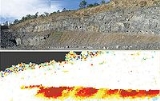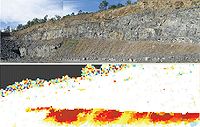
Slope stability radar
Encyclopedia
The Slope Stability Radar
(SSR) is a new application for the monitoring of slope stability
at open-cut mines. It is a system currently in use across the global mining
and civil industries.
 Slope stability
Slope stability
is a critical safety and production issue for open-cut mines around the world to understand the probability of mine wall failures. Many fatalities have occurred in mining due to slope failure - sudden rock and wall collapses. Even when there is no injury, there is a high cost due to lost production and often damaged equipment. A common technique to determine slope stability is to monitor the small precursory movements, which occur prior to collapse.
Slope Stability Radar, as a contemporary slope stability analysis
tool, have been developed to remotely scan a rock slope to monitor the spatial deformation of the face. Small movements of a rough wall can be detected with sub-millimeter accuracy by using interferometry
techniques. The effects of atmospheric variations and spurious signals can be reduced via signal processing means. The advantage of the slope stability radar over other monitoring techniques is that it provides full area coverage without the need for mounted reflectors or equipment on the wall. In addition, the radar waves adequately penetrate through rain, dust and smoke to give reliable measurements, in real-time and twenty-four hours a day.
A series of time measurements over time can be used to track movement of the rack slopes, and also detect variations in the rate of movement, which indicate instability. The radar information can be combined with various other information on a graphical display. Typical examples are 3-D models of the rock surface or pictures of the slope being monitored.
Slope stability radars are currently manufactured by companies in Australia, South Africa and Italy.
Radar
Radar is an object-detection system which uses radio waves to determine the range, altitude, direction, or speed of objects. It can be used to detect aircraft, ships, spacecraft, guided missiles, motor vehicles, weather formations, and terrain. The radar dish or antenna transmits pulses of radio...
(SSR) is a new application for the monitoring of slope stability
Automatic Deformation Monitoring System
An automatic deformation monitoring system is a group of interacting, interrelated, or interdependent software and hardware elements forming a complex whole for deformation monitoring that, once set up, does not require human input to function. Automatic deformation monitoring systems provide a...
at open-cut mines. It is a system currently in use across the global mining
Mining
Mining is the extraction of valuable minerals or other geological materials from the earth, from an ore body, vein or seam. The term also includes the removal of soil. Materials recovered by mining include base metals, precious metals, iron, uranium, coal, diamonds, limestone, oil shale, rock...
and civil industries.

Slope stability
The field of slope stability encompasses the analysis of static and dynamic stability of slopes of earth and rock-fill dams, slopes of other types of embankments, excavated slopes, and natural slopes in soil and soft rock...
is a critical safety and production issue for open-cut mines around the world to understand the probability of mine wall failures. Many fatalities have occurred in mining due to slope failure - sudden rock and wall collapses. Even when there is no injury, there is a high cost due to lost production and often damaged equipment. A common technique to determine slope stability is to monitor the small precursory movements, which occur prior to collapse.
Slope Stability Radar, as a contemporary slope stability analysis
Slope stability analysis
The slope stability analyses are performed to assess the safe and economic design of a human-made or natural slopes and the equilibrium conditions. The term slope stability may be defined as the resistance of inclined surface to failure by sliding or collapsing...
tool, have been developed to remotely scan a rock slope to monitor the spatial deformation of the face. Small movements of a rough wall can be detected with sub-millimeter accuracy by using interferometry
Interferometry
Interferometry refers to a family of techniques in which electromagnetic waves are superimposed in order to extract information about the waves. An instrument used to interfere waves is called an interferometer. Interferometry is an important investigative technique in the fields of astronomy,...
techniques. The effects of atmospheric variations and spurious signals can be reduced via signal processing means. The advantage of the slope stability radar over other monitoring techniques is that it provides full area coverage without the need for mounted reflectors or equipment on the wall. In addition, the radar waves adequately penetrate through rain, dust and smoke to give reliable measurements, in real-time and twenty-four hours a day.
A series of time measurements over time can be used to track movement of the rack slopes, and also detect variations in the rate of movement, which indicate instability. The radar information can be combined with various other information on a graphical display. Typical examples are 3-D models of the rock surface or pictures of the slope being monitored.
Slope stability radars are currently manufactured by companies in Australia, South Africa and Italy.

